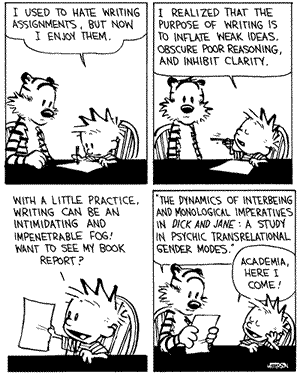The supplementary reading that I chose is "The Secret to Good Writing: It's About Objects, Not Ideas" by John Maguire. In the reading Maguire argues that many students today struggle with writing. He claims that students have trouble with being clearly and he says the way to solve this is through giving specific concrete examples. And the way to do this is through writing about physical objects.
Throughout the reading, Maguire states that students are too caught up in trying to write about abstract ideas that they have in their heads. He says that abstract writing leads to vague and unclear writing and this is why students struggle with writing. He tells his students that instead of writing abstractly, they should just write using "things they can drop on their feet" in order to write more clearly. Maguire uses this method since it is easy for students to write about concrete objects and that every student can do it. I agree with what he says in the article since I also had struggles with writing. I think that his tips would help me to portray what I am trying to write more clearly.
However, while looking at this passage I disagree with some of it, because I think that some of our writing should contain our abstract ideas and feelings. If we are able to write out these things in a concise manner, I believe that it adds emotion and power to our writing. If we only are describing objects throughout our whole writing, it can become boring and mundane. However if we are able to have a good balance between using abstract ideas and concrete description, our writing will improve greatly.
Maguire, John. “The Secret to Good Writing: It's About Objects, Not Ideas.” The Atlantic, Atlantic Media Company, 2 Oct. 2012, www.theatlantic.com/national/archive/2012/10/the-secret-to-good-writing-its-about-objects-not-ideas/263113/.
